Gardening is a hobby that brings immense joy to many people. Not only does it provide a great way to unwind, but it can also add significant value to your property. One of the essential aspects of gardening is selecting the right trees to plant in your garden. Trees are aesthetically pleasing and have numerous benefits for the environment, such as purifying the air, reducing noise pollution, and providing shade. However, choosing the right trees can be a daunting task, especially for novice gardeners. In this blog, we’ll guide you through the best trees for your garden and provide tips for their care to ensure that they thrive and enhance the beauty of your outdoor space.
Selecting the Best Tree
Japanese Maple
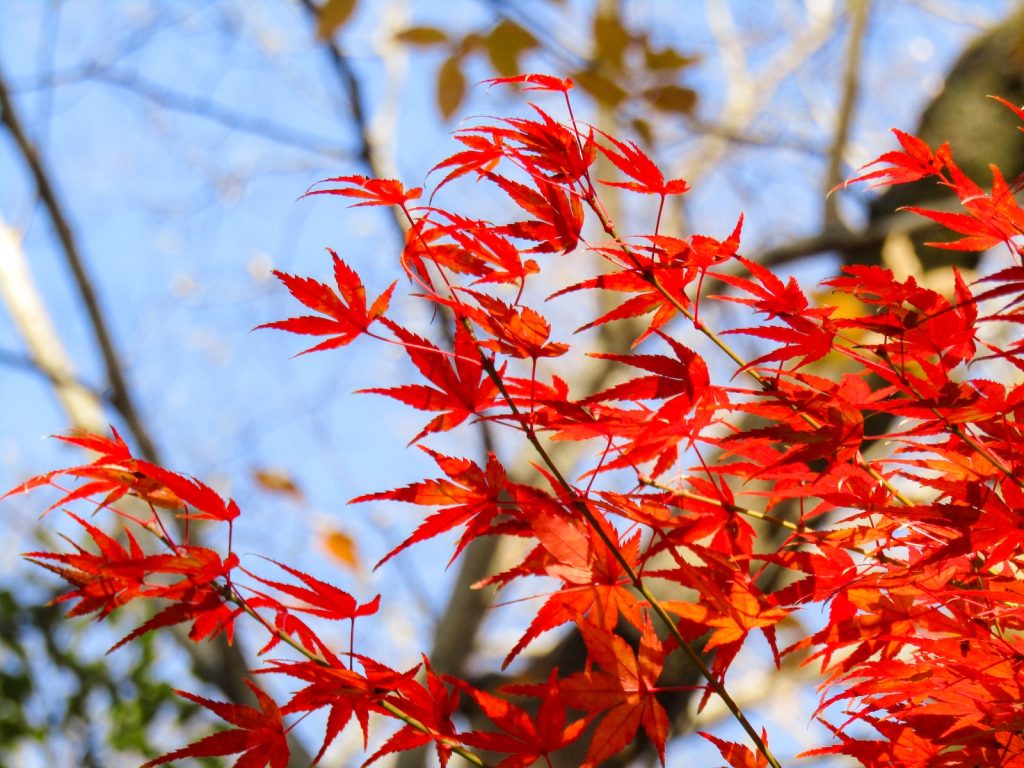
Japanese Maple (Acer palmatum) is a beautiful tree native to Japan, Korea, and China. It’s a popular ornamental tree because of its attractive foliage, which comes in a range of colors and shapes, and its striking appearance in the fall. Japanese maples are slow-growing and typically reach a height of 15-25 feet, making them ideal for smaller gardens.
One of the unique features of the Japanese Maple is its foliage, which can come in a range of colors, including red, green, gold, and purple. The leaves are typically deeply lobed and have a delicate, lacy appearance that adds a touch of elegance to any garden. Some varieties of Japanese Maple also have interesting bark textures or colors that make them a standout feature in the winter landscape.
Japanese Maples prefer partial shade and well-draining soil, making them an excellent choice for gardens with limited sunlight. They can also be grown in containers or as bonsai, making them a versatile option for any size garden. Japanese Maples are relatively low-maintenance but benefit from regular pruning to maintain their shape and size.
In addition to their aesthetic appeal, Japanese Maples are also believed to have several health benefits. The leaves and bark have been used in traditional medicine to treat a range of conditions, including arthritis, high blood pressure, and inflammation.
Overall, the Japanese Maple is an excellent choice for any garden. Its unique beauty, easy care, and versatility make it a standout addition to any landscape.
Dogwood
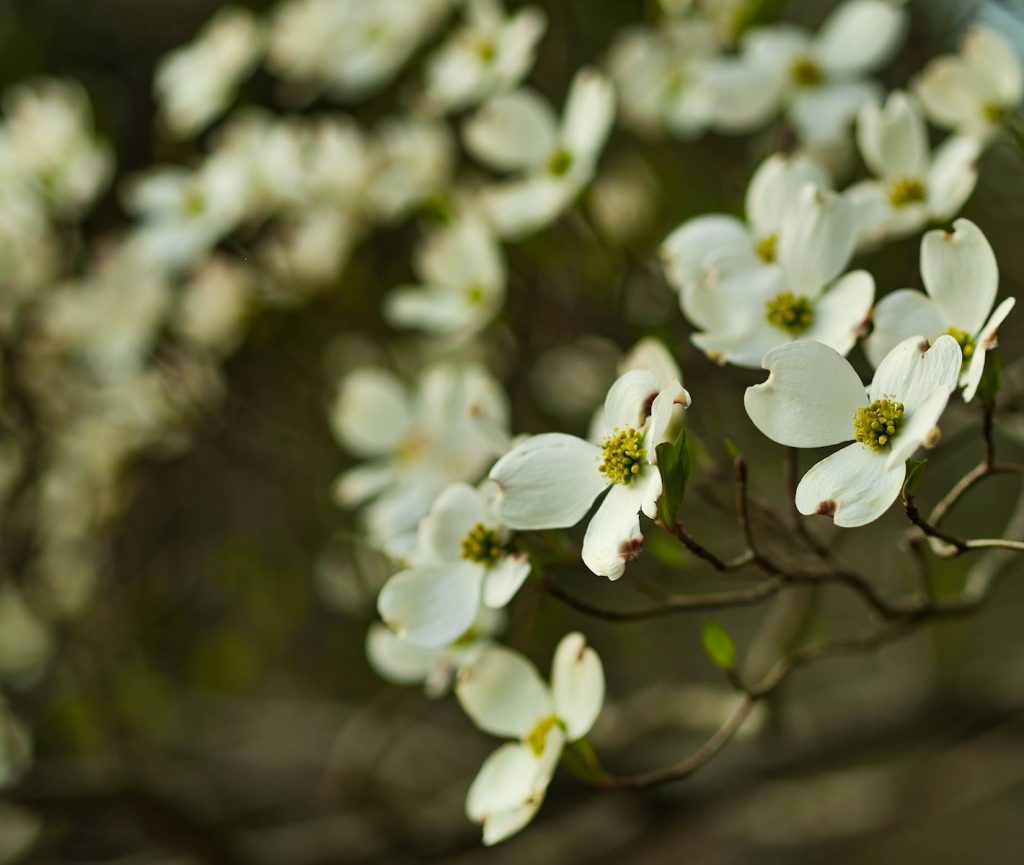
Dogwood trees (Cornus florida) are a beloved addition to many gardens, thanks to their showy flowers, attractive bark, and brilliant autumn foliage. These deciduous trees are native to the eastern United States and typically reach a height of 20-30 feet with a spread of 25-30 feet.
Dogwood trees are known for their showy flowers, which bloom in the spring and range in color from white to pink to red. The flowers are actually bracts, or modified leaves, surrounding the tiny, inconspicuous flowers. The bracts can be up to 4 inches wide, creating a stunning display in any garden. In the fall, the leaves turn a rich shade of red or purple, adding to the tree’s beauty.
Another notable feature of Dogwood trees is their bark. The bark is grayish-brown and develops a distinctive blocky pattern as the tree matures. This makes the tree a standout feature in the winter landscape.
Dogwood trees prefer well-drained soil and partial shade, making them an excellent choice for gardens with limited sunlight. They are relatively low-maintenance, although they can be susceptible to a few diseases and pests, including powdery mildew and dogwood borers. Proper care, including regular pruning and keeping the soil moist but not waterlogged, can help keep these issues at bay.
In addition to their beauty, Dogwood trees also have a rich cultural history. They have been used in traditional medicine to treat a range of conditions, and the flowers have been used in food and drink recipes for centuries.
Overall, the Dogwood tree is an excellent choice for any garden. Its showy flowers, attractive bark, and stunning autumn foliage make it a standout feature in any landscape.
Magnolia
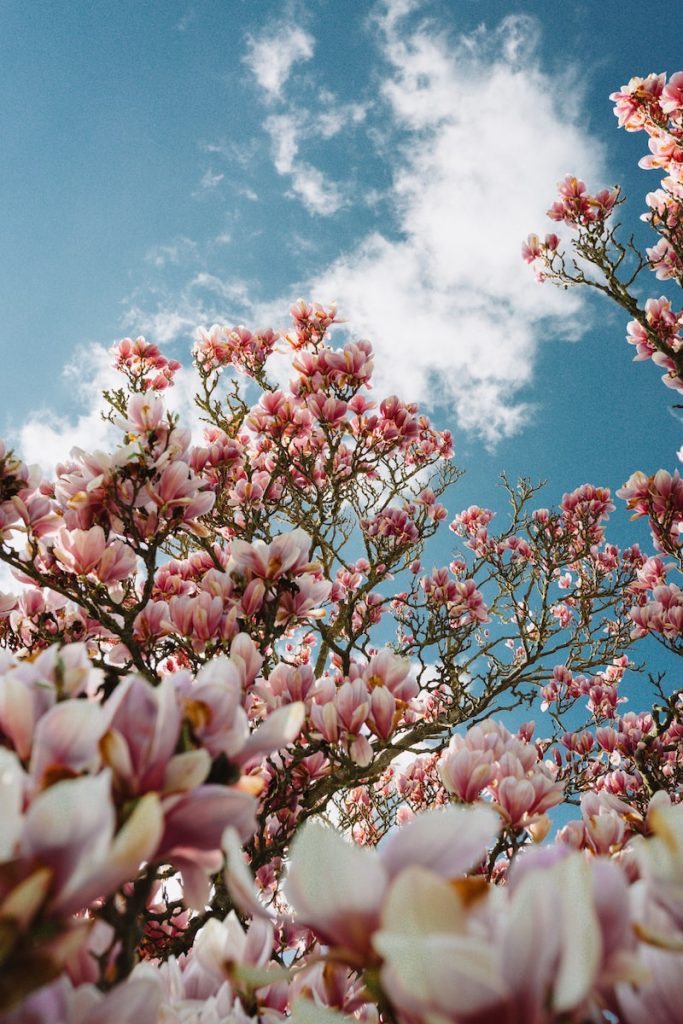
Magnolias are a group of deciduous and evergreen trees and shrubs native to Asia and the Americas. These trees are prized for their stunning, fragrant flowers, which range in color from white to pink to purple, and their glossy green leaves. Magnolias can grow to be quite large, with some species reaching heights of up to 100 feet, although many garden varieties stay smaller.
The most well-known magnolia species is probably the Southern Magnolia (Magnolia grandiflora), native to the southeastern United States. This evergreen tree produces large, fragrant, creamy-white flowers that can reach up to a foot in diameter. The leaves of the Southern Magnolia are also large and glossy, adding to the tree’s beauty. Other popular magnolia species for gardens include the Saucer Magnolia (Magnolia x soulangeana), which produces large, pink or purple flowers in the early spring, and the Star Magnolia (Magnolia stellata), which has fragrant white or pink flowers that resemble stars.
Magnolias prefer well-drained soil and full sun to partial shade. They are relatively low-maintenance trees, although they may require some pruning to maintain their shape and size. Magnolias are also relatively pest-resistant, although they can sometimes be susceptible to scale insects and fungal diseases.
In addition to their beauty, magnolias have a long history of medicinal and culinary use. The bark and flowers of some magnolia species have been used in traditional medicine to treat various conditions, including anxiety, depression, and inflammation. The flowers are also edible and can be used in teas, syrups, and baked goods.
Overall, magnolias are a stunning addition to any garden. Their fragrant flowers, glossy leaves, and easy maintenance make them an excellent choice for gardeners of all levels.
Crabapple
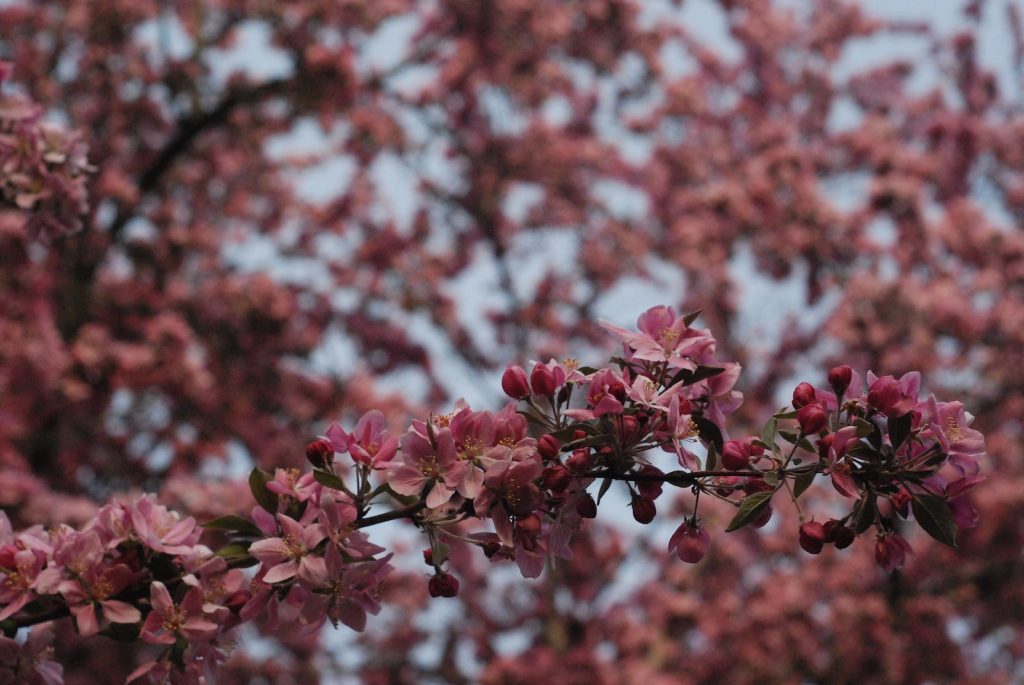
Crabapple trees (Malus) are small to medium-sized deciduous trees known for their showy spring blossoms and colorful autumn fruits. There are dozens of species and hundreds of cultivars of crabapple trees, making them a versatile addition to any garden. They are native to North America, Europe, and Asia.
Crabapple trees produce clusters of fragrant flowers in the spring, ranging in color from white to pink to red. The flowers are followed by small, round fruits that vary in color from yellow to green to red. Some varieties of crabapple trees have fruit that persists on the tree well into the winter, providing a source of food for wildlife.
Crabapple trees are relatively easy to grow and require full sun, partial shade, and well-draining soil. They are also relatively disease-resistant, although some varieties can be susceptible to apple scab, a fungal disease that can cause leaf spots and premature leaf drop. Regular pruning can help keep the tree healthy and reduce disease risk.
In addition to their ornamental value, crabapple trees have a long history of culinary use. The tart fruits can be used to make jams, jellies, and sauces; some varieties are even used to make cider. The fruit is also a rich source of antioxidants and vitamin C.
Overall, crabapple trees are an excellent choice for any garden. Their showy blossoms, colorful fruits, and easy maintenance make them stand out in any landscape.
Crape Myrtle
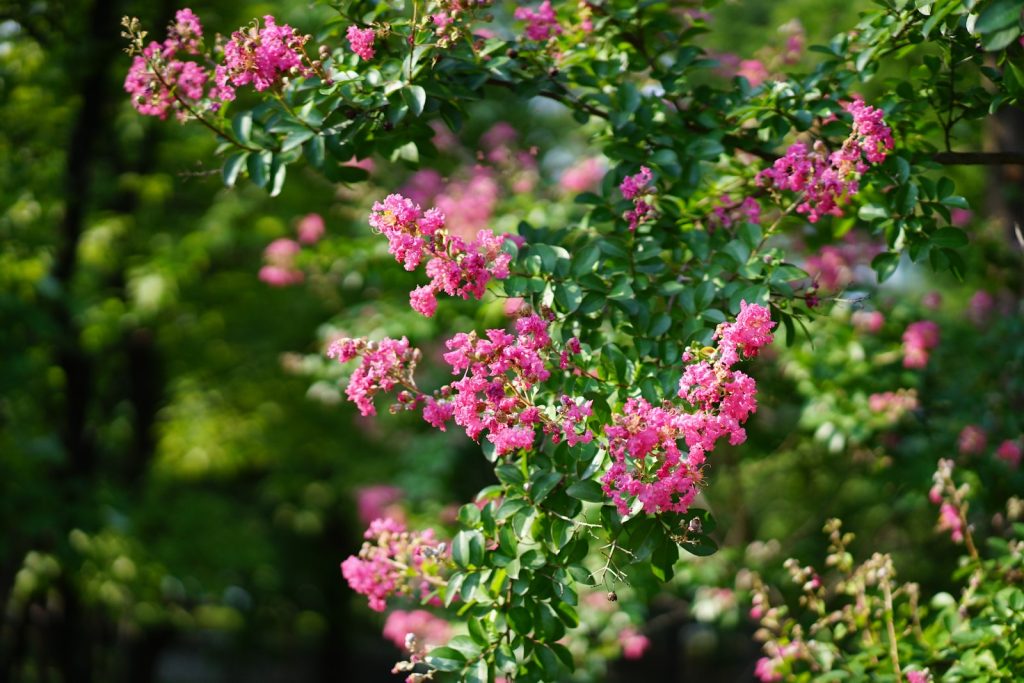
Crape Myrtle (Lagerstroemia indica) is a small to medium-sized deciduous tree native to China, Korea, and Japan. It is widely grown in the southern United States, where it is valued for its showy summer blooms, attractive bark, and brilliant fall foliage.
Crape Myrtle trees produce large, showy clusters of flowers in the summer, ranging in color from white to pink to red to purple. The flowers are followed by small, oval-shaped fruits that are a favorite food of birds. The bark of Crape Myrtle trees is also attractive, with smooth, peeling bark that ranges in color from gray to brown to reddish-brown.
Crape Myrtle trees are relatively easy to grow and require full sun and well-drained soil. They are also relatively drought-tolerant once established. Crape Myrtles are often pruned in the late winter or early spring to encourage the growth of new branches and blooms. They are relatively pest-resistant but can be susceptible to powdery mildew in humid climates.
In addition to their ornamental value, Crape Myrtle trees have a long history of medicinal use. The bark of the tree has been used in traditional Chinese medicine to treat a range of conditions, including diarrhea, dysentery, and malaria.
Overall, Crape Myrtle trees are an excellent choice for any garden. Their showy blooms, attractive bark, and easy maintenance make them a standout feature in any landscape. They are also relatively pest-resistant and drought-tolerant, making them a good choice for gardeners in hot, dry climates.
Tree Care Basics
Tree care is an essential part of maintaining a healthy and attractive garden. Proper care can help trees thrive, prevent damage to property and people, and increase the value of your home. Here are some tree care basics that every gardener should know:
- Watering: Trees need regular watering, especially during their first few years of growth. Deep watering once or twice a week is usually sufficient. Water should be applied slowly and evenly to the soil around the tree’s base, allowing it to soak in.
- Fertilizing: Trees can benefit from occasional fertilization to promote healthy growth. Slow-release fertilizers are usually the best choice, as they release nutrients over time and are less likely to burn the tree’s roots.
- Pruning: Regular pruning can help trees maintain shape, prevent disease, and remove dead or damaged branches. Pruning should be done in the late winter or early spring before new growth begins.
- Mulching: Mulching around the base of a tree can help retain moisture, prevent soil erosion, and suppress weed growth. Organic mulches like wood chips or shredded bark are usually the best choice, as they break down slowly and add nutrients to the soil.
- Pest and Disease Control: Trees can be susceptible to a range of pests and diseases, including aphids, scale insects, and fungal infections. Regular monitoring and prompt treatment can help prevent serious damage.
- Protection: Trees can be damaged by lawnmowers, weed trimmers, and other garden equipment. Placing a protective barrier around the tree’s base can help prevent accidental damage.
By following these basic tree care tips, you can help ensure your trees stay healthy, attractive, and safe for years. If you have questions about caring for a specific tree species, consult a local gardening expert or arborist.
Conclusion: Enjoy Your Garden
In conclusion, your garden is a place where you can relax, connect with nature, and express your creativity. By choosing the right trees for your garden and providing them with proper care, you can create a beautiful and welcoming outdoor space that you can enjoy for years to come.
When choosing, remember to select trees well-suited to your climate and soil conditions and consider factors like size, shape, and color. Take care to water, fertilize, prune, mulch, and protect your trees to help them thrive and prevent damage to your property and people.
With a little bit of effort and attention, your garden can become a peaceful oasis where you can escape from daily life’s stresses and enjoy nature’s beauty and tranquility. So, roll up your sleeves, get your hands dirty, and start creating the garden of your dreams today!






























